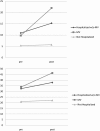Disability among elderly survivors of mechanical ventilation
- PMID: 21057004
- PMCID: PMC3159078
- DOI: 10.1164/rccm.201002-0301OC
Disability among elderly survivors of mechanical ventilation
Abstract
Rationale: Studies of long-term functional outcomes of elderly survivors of mechanical ventilation (MV) are limited to local samples and biased retrospective, proxy-reported preadmission functional status.
Objectives: To assess the impact on disability of hospitalization with MV, compared with hospitalization without MV, accounting for prospectively assessed prior functional status.
Methods: Retrospective population-based longitudinal cohort study of Medicare beneficiaries age 65 and older enrolled in the Medicare Current Beneficiary Survey, 1996-2003.
Measurements and main results: Premeasures and postmeasures of disability included mobility difficulty and weighted activities of daily living disability scores ranging from 0 (not disabled) to 100 (completely disabled) based on self-reported health and functional status collected 1 year apart. Among 54,771 person-years (PY) of observation over 7 calendar years of data, 42,890 PY involved no hospitalization, 11,347 PY involved a hospitalization without MV, and 534 PY included a hospitalization with MV. Mortality at 1 year was 8.9%, 23.9%, and 72.5%, respectively. The level of disability at the postassessment was substantially higher for a prototypical patient who survived after hospitalization with MV (adjusted activities of daily living disability score [95% confidence interval] 14.9 [12.2-17.7]; adjusted mobility difficulty score [95% confidence interval] 25.4 [22.4-28.4]) compared with an otherwise identical patient who survived hospitalization without MV (11.5 [11.1-11.9] and 22.3 [21.8-22.9]) or who was not hospitalized (8.0 [7.9-8.1] and 13.4 [13.3-13.6]).
Conclusions: The greater marginal increase in disability among survivors of MV compared with survivors of hospitalization without MV is larger than would be predicted from prior functional status.
Figures



Comment in
-
The functional costs of ICU survivorship. Collaborating to improve post-ICU disability.Am J Respir Crit Care Med. 2011 Apr 15;183(8):962-4. doi: 10.1164/rccm.201012-2042ED. Am J Respir Crit Care Med. 2011. PMID: 21498817 No abstract available.
References
-
- Cohen IL, Lambrinos J. Investigating the impact of age on outcome of mechanical ventilation using a population of 41,848 patients from a statewide database. Chest 1995;107:1673–1680. - PubMed
-
- Ely EW, Evans GW, Haponik EF. Mechanical ventilation in a cohort of elderly patients admitted to an intensive care unit. Ann Intern Med 1999;131:96–104. - PubMed
-
- Kurek CJ, Dewar D, Lambrinos J, Booth FV, Cohen IL. Clinical and economic outcome of mechanically ventilated patients in New York State during 1993: analysis of 10,473 cases under DRG 475. Chest 1998;114:214–222. - PubMed
-
- Pesau B, Falger S, Berger E, Weimann J, Schuster E, Leithner C, Frass M. Influence of age on outcome of mechanically ventilated patients in an intensive care unit. Crit Care Med 1992;20:489–492. - PubMed
Publication types
MeSH terms
Grants and funding
LinkOut - more resources
Full Text Sources
Medical

